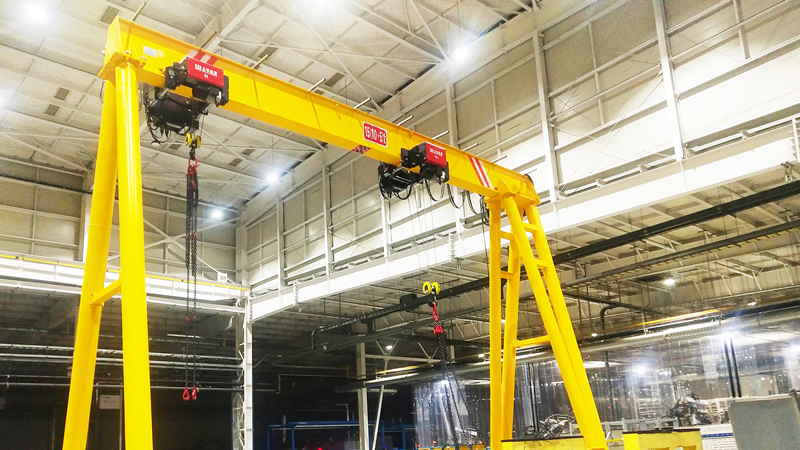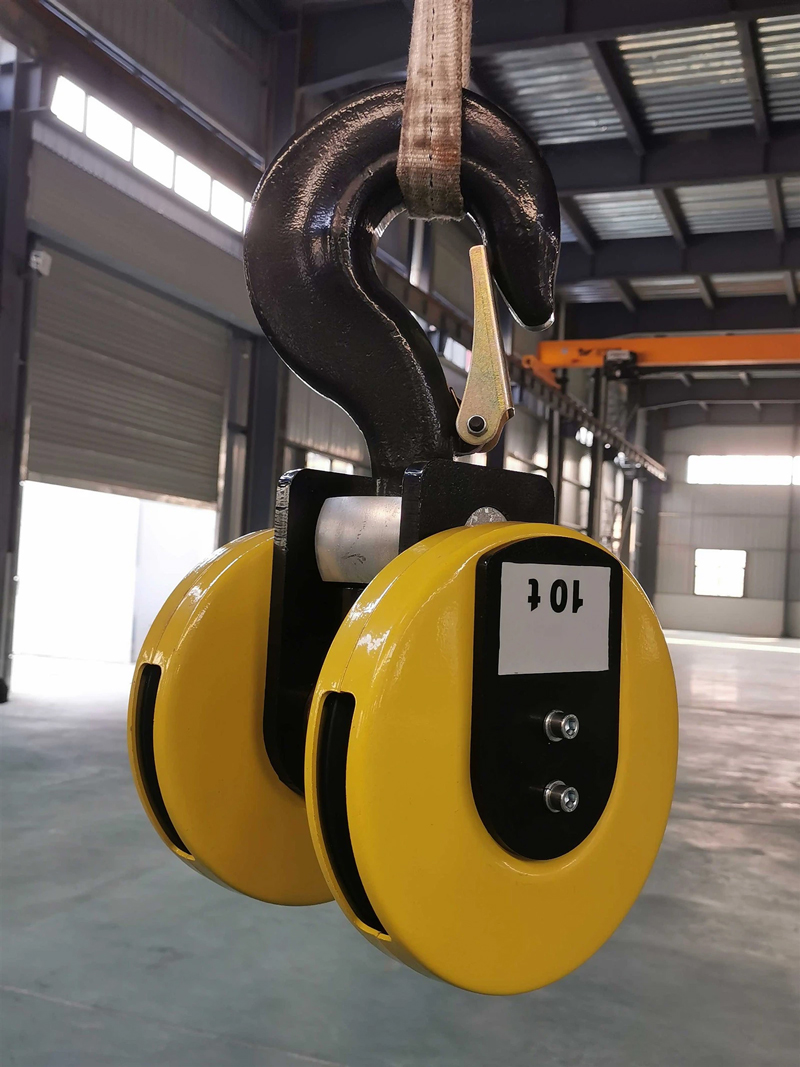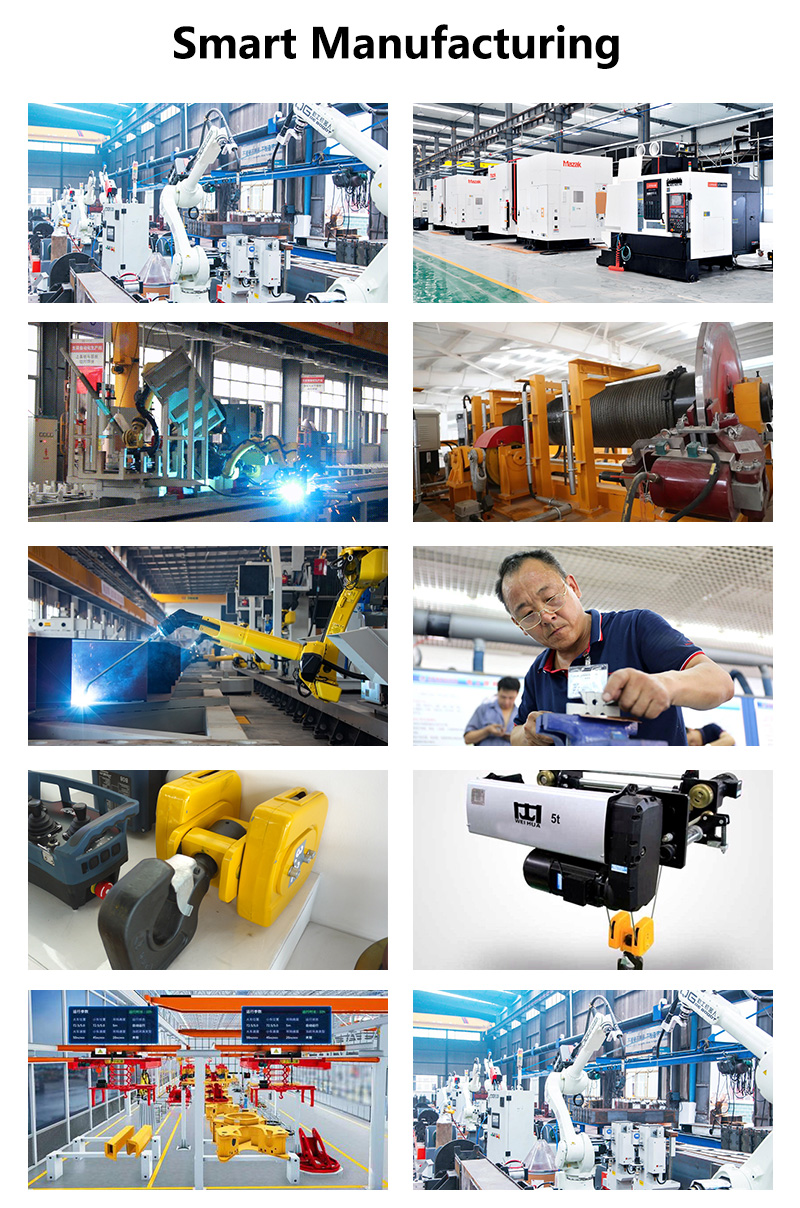در بلوک قلاب جرثقیل is an unsung hero of the lifting world. Nestled at the end of the hoist ropes or chain, this deceptively simple-looking assembly is the critical link between your crane and the load. Choosing the right type isn’t just about efficiency; it’s paramount for safety and operational success. But with various designs available, how do you know which بلوک قلاب جرثقیل is right for your application? Let’s break down the main types.

شرح: The most basic type, featuring one sheave (pulley wheel) and a single hook.
Function: Designed for straightforward lifts with a single part of line. The rope runs over the sheave and directly to the winch drum.
برنامه: Ideal for lighter loads, simple hoists, jib cranes, or situations where minimal height loss is critical. Often seen on monorails or smaller electric chain hoists.
مزایا: Compact, سبک وزن, simple design, مقرون به صرفه, minimal headroom required.
Disadvantages: Limited mechanical advantage (no reeving multiplier), suitable only for lighter capacities.
شرح: The workhorse of the industry. Features multiple sheaves (به طور معمول 2, 3, 4, 6, or more) arranged in a frame, with a central hook. The rope is “reeved” through the sheaves multiple times.
Function: Provide significant mechanical advantage. The number of “parts of line” (the number of rope segments supporting the load) is determined by how the rope is threaded through the block’s sheaves and the crane’s upper sheaves (the fixed block). More parts of line mean the hoist motor/drum bears less force to lift the same weight, allowing lifting of heavier loads with a smaller motor/rope.
برنامه: Extremely versatile. Used on virtually all types of cranes (overhead bridge cranes, جرثقیل های گانی, tower cranes, جرثقیل های سیار) for medium to very heavy lifting. The number of sheaves is chosen based on the required load capacity and the desired lifting speed/hoist power.
مزایا: High mechanical advantage, suitable for heavy loads, widely available, various configurations.
Disadvantages: Larger and heavier than single sheave blocks, require more headroom, reeving can be more complex.

شرح: Incorporate a bearing mechanism between the hook and the block frame, allowing the hook (and attached load) آزادانه بچرخد 360 درجه.
Function: Prevents the load from inducing twist into the hoist ropes when it naturally wants to spin. This is crucial for loads that are unbalanced, long, or prone to rotation (like pipes, ماشین آلات, or fabricated structures).
برنامه: Lifting long beams, لوله, کویل ها, pre-cast concrete elements, ماشین آلات, or any load susceptible to twisting. Essential for preventing dangerous rope spin-up and uncontrolled load rotation.
مزایا: Enhances load control and stability, reduces rope wear from twisting, improves safety during rotation-critical lifts.
Disadvantages: More complex and expensive than fixed hook blocks, requires periodic bearing maintenance.
شرح: در قلاب is rigidly fixed to the block frame and cannot rotate independently.
Function: Provides a stable, non-rotating connection point. Relies on the natural twist of the hoist ropes or external tag lines to control load rotation if needed.
برنامه: Lifting balanced loads unlikely to spin (like palletized goods, ظروف, balanced machinery bases), or in systems specifically designed to manage rotation via other means. Commonly found on many standard multi-sheave blocks.
مزایا: Simpler design, generally more robust and lower cost than swivel types, less maintenance.
Disadvantages: Unsuitable for loads prone to twisting, can cause dangerous rope spin-up if the load rotates unexpectedly.
شرح: Designed for unique or demanding applications.
نمونه ها:
Foundry Hooks/Blocks: Heavily heat-shielded and constructed with materials resistant to radiant heat and splashes, often with larger throat openings.
High-Capacity Blocks: Engineered for extreme loads (hundreds or thousands of tons), featuring massive sheaves, specialized bearings, and reinforced frames.
Low-Headroom Blocks: Designed with a very compact profile (به عنوان مثال, using side plates instead of top/bottom plates) to maximize lift height in constrained spaces.
Twin Hook Blocks: نشان جرثقیل دو قلاب on a single block, allowing for balanced lifting of longer loads or simultaneous handling of multiple items (within strict load distribution limits).
Electrically Rotating Hook Blocks: Incorporate a motorized gear drive for powered rotation, offering precise load positioning control.

ظرفیت بار (SWL – Safe Working Load): MUST exceed the maximum intended load, including rigging weight. Never exceed the rated capacity stamped on the block.
Number of Sheaves & Reeving: Dictates the mechanical advantage and compatibility with your crane’s hoist system (rope size, drum capacity, required parts of line).
سر: The physical height of the block impacts how high you can lift the load within your crane’s available hook height.
Rotation Requirement: Does the load need to rotate freely (swivel block), be prevented from rotating (anti-rotation), or be power-rotated? Choose accordingly.
محیط زیست: Consider heat (foundry), خوردگی (marine/chemical), abrasion, or explosive atmospheres. Select appropriate materials, coatings, or specialized designs.
Hook Size & افتتاح گلو: Must accommodate the slings, قلاده, or lifting devices you plan to use and fit around the load.
رعایت: Ensure the block meets relevant safety standards (به عنوان مثال, ASME B30.10, مقررات OSHA, CMAA specs).


Always inspect your بلوک قلاب جرثقیل thoroughly before every use. به دنبال ترک ها باشید, تغییر شکل, excessive wear on sheaves or hooks, damaged bearings (in swivel blocks), شکسته قفل ایمنی قلاب جرثقیل, or missing/corroded capacity tags. Regular preventive maintenance and professional inspections according to the manufacturer’s guidelines and regulations are non-negotiable for safe operation.
From the simple single sheave to complex multi-sheave rotating giants, the right بلوک قلاب جرثقیل is fundamental to safe and efficient lifting. Understanding the different types – single, multi-sheave, چرخشی, anti-rotation, and specialty blocks – empowers you to make the correct selection for your specific crane and lifting task. Prioritize capacity, functionality, محیط زیست, and above all, امنیت. When in doubt, consult with crane and rigging specialists to ensure you have the optimal بلوک قلاب جرثقیل for the job.
ما برای بازخورد شما ارزش قائل هستیم! لطفاً فرم زیر را تکمیل کنید تا بتوانیم خدمات خود را متناسب با نیازهای خاص شما تنظیم کنیم.


برای به دست آوردن اطلاعات محصول و نقل قول های موجود در WhatsApp روی دکمه کلیک کنید.
نقل قول
آخرین نظرات